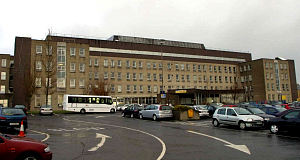 INSPECTORS have found dirty baths at Letterkenny General Hospital posed a significant health risk to newborn babies.
INSPECTORS have found dirty baths at Letterkenny General Hospital posed a significant health risk to newborn babies.
A damning report released today by the Health Information and Quality Authority also attacked ‘lax management’ at the hospital – for allowing unlocked rooms where chemicals, painkillers and other strong medications and syringes were stored.
Inspectors also found fire hazards, rusty baby weighing scales, mould, dust and debris during an unannounced visit to the surgical, medical and maternity wards of the 318-bed hospital.
The shocking report said while there was some evidence of good practice on the wards, overall they were “unclean”.
“This would suggest that the physical environment was not effectively managed and maintained to protect patients and reduce the spread of healthcare associated infections,” the report on its website states.
“This poses a significant risk to patients.”
The inspection took place less than two months ago – on February 27, a month before the arrival of Health Minister James Reilly.
Inspectors found dusty baby baths were stored along a corridor of the maternity ward.
As there was no system in place for cleaning the baby baths there was no way of knowing whether or not they had been washed or were awaiting being washed, the report found.
Hiqa said as mothers took baby baths from the corridor as they needed them, there was a risk of their newborns contracting an infection from them.
Inspectors warned the clinical nurse manager about the threat.
There was dust on a baby resusitaire in a room used for mothers who had caesarean sections, a dusty bed and baby cot, rusty baby scales and debris on the floor.
There was no facility for cleaning bedpans on the maternity ward, while there was visible dust and grit on floors and walls.
In the surgical ward, there was dust on beds, electrical fixtures, on a cardiac monitor, resuscitation trolley and blood pressure monitoring equipment as well as other surfaces.
Mould-like substance was found on wall tiles, in the shower and around sink taps.
A treatment room containing antibiotics, needles, syringes was unlocked while a separate utility room with chemicals, antibiotics, anti-epileptic drugs and painkillers in unsecured cupboards was also left open.
“Both medication fridges, containing items such as insulin and other drugs, were unsecured, enabling unobstructed public access,” the inspectors warned.
“This poses a health and safety risk and was brought to the attention of the ward’s clinical nurse managers.”
In the emergency ward, three wheelchairs were blocking fire fighting equipment.
Despite the health and safety hazard being brought to the attention of management – who immediately removed them – they were later spotted in the same position.
An inspection in Sligo on February 28 found damning incidents there too..
Used IV equipment, including unsterile surgical tubes known as cannulae, were found sitting on a worktop while a hazardous sharps bin was overflowing.
Inspectors saw three patients with known transmissable infections in rooms with the doors left open near other patients and gear to protect medics from contamination was not disposed of appropriately.
In the surgical gynaecology ward a soiled toilet brush was inappropriately stored in its holder beside a sink in a cleaners’ room and in A&E, sticky residue and stains were found on a bedpan washing machine. Inspectors also reported seeing stained bedpans and yellow stains on the seat of a commode in the room.
Mould was spotted in the dirty utility room of the ward, Hiqa said.
The watchdog warned that patients in the hospital were at risk of the spread of healthcare associated infections.
The inspectors said they saw 39 hand hygiene opportunities for staff with 23 taken, but they warned only 11 complied with best practice.
Hiqa inspected the emergency department, the gynaecology and medical south wards in Sligo’s 318-bed regional hospital.
In one incident cleaning equipment was left by a fire exit on the sixth floor of the surgical gynaecology unit potentially blocking a quick escape.
The report warned that the culture of hand hygiene, a vital tool in stopping infection, was not embedded among the hospital’s staff.
There was further evidence of a general lack of hygiene with sticky residue reported on a fridge used for storing medication in the medical south ward and on IV stands, dressing trolleys, cupboards of the dirty utility room and in A&E on phone handsets and wires.
A dirty urine testing unit was found and a raised toilet seat had been left sitting on the floor beside an in-use toilet.